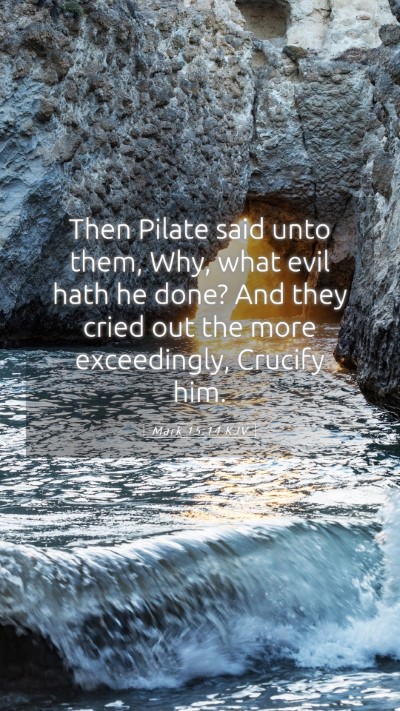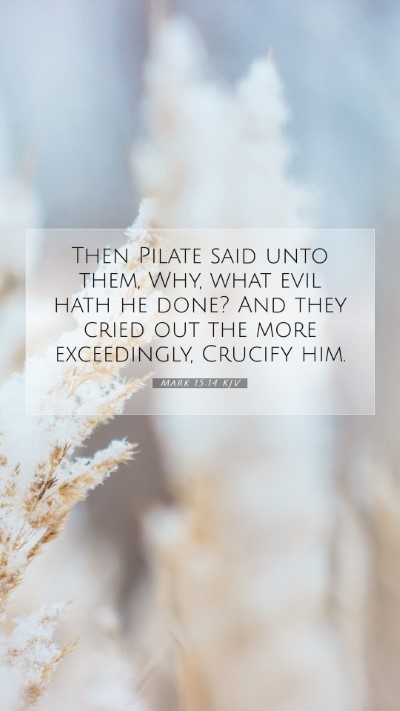Understanding Mark 15:14
Mark 15:14 states, "Then Pilate said to them, 'Why? What evil has He done?' But they cried out all the more, 'Crucify Him!' This verse captures the intense moment during the trial of Jesus, highlighting the conflict between justice and mob mentality. Several public domain commentaries provide valuable insights into this verse, offering a multifaceted understanding of its meaning.
Contextual Background
The events leading to this verse take place during the trial of Jesus before Pontius Pilate. Pilate was the Roman governor, and he faced the difficult task of delivering justice amidst a frenzied crowd demanding Jesus' crucifixion. The dynamics of this trial illustrate the broader themes of innocence, political pressure, and the fulfillment of prophecy.
Commentary Insights
-
Matthew Henry's Commentary:
Matthew Henry emphasizes the absurdity of the crowd's insistence on crucifying an innocent man. He notes how Pilate’s question—“What evil has He done?”—reflects his recognition of Jesus' innocence. Henry highlights the moral blindness of the people as they choose Barabbas over Jesus, symbolizing the world's embrace of sin over righteousness.
-
Albert Barnes' Notes:
Albert Barnes reflects on the historical significance of this moment. He explains that Pilate's effort to absolve himself of responsibility only underlines the gravity of the crowd's actions. Pilate's question reveals his internal conflict, yet he ultimately succumbs to the pressures of public opinion. Barnes conveys that this moment foreshadows how society often rejects truth in favor of popular demands.
-
Adam Clarke's Commentary:
Adam Clarke delves into the psychological aspect of the crowd's demand. He points out how the people's fervor can lead to irrationality, showcasing the dangers of collective decision-making devoid of personal responsibility. Clarke emphasizes that Pilate's role as a leader was compromised by his desire to maintain his position, leading to tragic consequences that fulfill Old Testament prophecies.
Key Themes and Interpretations
-
Innocence vs. Guilt:
This verse starkly contrasts Jesus' innocence with the crowd's desire for violence. The insistence on crucifixion despite a lack of evidence signifies a deep moral and spiritual failure.
-
The Power of Public Opinion:
The verse underscores the influence of the mob and how public opinion can sway decisions, often against justice and truth. It prompts reflection on modern-day parallels in societal behavior and decision-making.
-
Fulfillment of Prophecy:
Jesus' rejection by His people and His subsequent crucifixion fulfill numerous prophetic scriptures, illustrating God’s sovereignty over human actions, even those driven by malice.
Applications for Today
Understanding Mark 15:14 invites believers to consider their responses to societal pressures. It encourages seekers of truth to stand firm in their beliefs despite popular opposition, reflecting on how they can embody Christ-like courage in personal and communal settings.
Cross References
- Isaiah 53:3 - Describes the servant who was despised and rejected by men.
- John 18:38 - Pilate asks, “What is truth?” reflecting his confusion and moral dilemma.
- Matthew 27:24-26 - Details Pilate's washing of his hands to show he was innocent of Jesus' blood.
Conclusion
In summary, Mark 15:14 serves as a poignant reminder of the complexities of human nature and the dynamics of justice, guilt, and societal influence. It encourages readers to reflect on the significance of their choices and the importance of standing for truth amid prevailing opposition.


